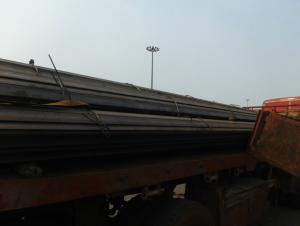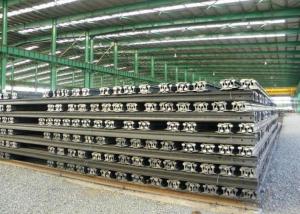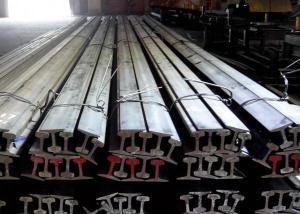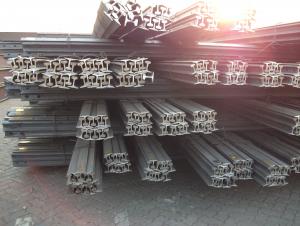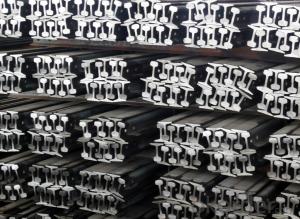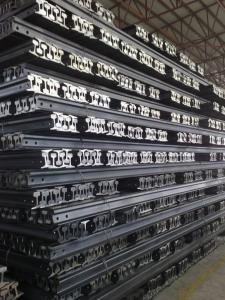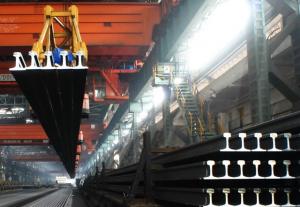Steel Light Rail GB 11264-89, DIN, AREMA, JIS, BS, UIC
- Loading Port:
- China main port
- Payment Terms:
- TT or LC
- Min Order Qty:
- 25 m.t.
- Supply Capability:
- 100000 m.t./month
OKorder Service Pledge
OKorder Financial Service
You Might Also Like
Product Description of Steel Light Rail GB 11264-89, DIN, AREMA, JIS, BS, UIC:
Alloy No | Grade | Element(%) | ||||
C
| Mn | S
| P
| Si
| ||
Q235 |
B
|
0.12—0.20 |
0.3—0.7 |
≤0.045 |
≤0.045
|
≤0.3
|
Invoicing on theoretical weight or actual weight as customer request
Payment terms: 30% advance payment by T/T, 70% payment against the copy of the B/L; 100% L/C at sight, etc.
Usages of Steel Light Rail GB 11264-89, DIN, AREMA, JIS, BS, UIC:
Light rail is mainly used in forest region, mines, factories and construction sites laid of the place such as temporary transport line and light motorcycles with line. Be widely used for railway, subway, transportation track, express, curve way, tunnel way and so on.
Packaging & Delivery of Steel Light Rail GB 11264-89, DIN, AREMA, JIS, BS, UIC:
1. Packing: it is nude packed in bundles by steel wire rod
2. Bundle weight: not more than 3.5MT for bulk vessel; less than 3 MT for container load
3. Marks:
Color marking: There will be color marking on both end of the bundle for the cargo delivered by bulk vessel. That makes it easily to distinguish at the destination port.
Tag mark: there will be tag mark tied up on the bundles. The information usually including supplier logo and name, product name, made in China, shipping marks and other information request by the customer.
If loading by container the marking is not needed, but we will prepare it as customer request.
4. Transportation: the goods are delivered by truck from mill to loading port, the maximum quantity can be loaded is around 40MTs by each truck. If the order quantity cannot reach the full truck loaded, the transportation cost per ton will be little higher than full load.
5. Delivered by container or bulk vessel
6. Delivery Time: All the Hot Rolled Steel Rail will be transpoted at the port of Tianjin, China within 30 days after receiving the advance payment by T/T or the orginal L/C at sight.
Inspection of Steel Light Rail GB 11264-89, DIN, AREMA, JIS, BS, UIC:
We will send the MTC of the factory to the clients dirrectly which contain the anlisis of the heat, chemiqul composition, phisical characteristicas, etc.
And our inspectors will arrive at the factory to meke the inspection of the size, length, weight and quantity before the transportation from the factory.
FAQ:
Q1: Why buy Materials & Equipment from OKorder.com?
A1: All products offered byOKorder.com are carefully selected from China's most reliable manufacturing enterprises. Through its ISO certifications, OKorder.com adheres to the highest standards and a commitment to supply chain safety and customer satisfaction.
Q2: How do we guarantee the quality of our products?
A2: We have established an advanced quality management system which conducts strict quality tests at every step, from raw materials to the final product. At the same time, we provide extensive follow-up service assurances as required.
Q3: How soon can we receive the product after purchase?
A3: Within three days of placing an order, we will begin production. The specific shipping date is dependent upon international and government factors, but is typically 7 to 10 workdays
Images:


- Q:How long do steel rails last?
- Steel rails typically have a lifespan of around 30 to 40 years, depending on various factors such as maintenance, usage, and environmental conditions.
- Q:Can steel rails be used in mining railways?
- Yes, steel rails can be used in mining railways. In fact, steel rails are commonly used in mining operations due to their strength and durability. Mining railways often need to withstand heavy loads and harsh conditions, and steel rails provide the necessary support and stability. Additionally, steel rails can be easily maintained and repaired, ensuring the smooth and efficient transportation of materials in mining operations. Overall, steel rails are a reliable and cost-effective choice for mining railways.
- Q:How are steel rails affected by temperature changes?
- Steel rails are affected by temperature changes in that they expand or contract based on the temperature fluctuations. This can lead to changes in the dimensions of the rails, causing stress and potential issues with alignment.
- Q:What are the main causes of rail fractures in steel rails?
- The main causes of rail fractures in steel rails can be attributed to factors such as heavy loading, dynamic forces from passing trains, changes in temperature, poor maintenance practices, and material defects.
- Q:What are the different methods used for rail inspection on steel rails?
- There are several methods used for rail inspection on steel rails, including visual inspection, ultrasonic testing, magnetic particle inspection, and eddy current testing. Visual inspection involves examining the rail surface for any visible defects such as cracks, wear, or corrosion. Ultrasonic testing uses high-frequency sound waves to detect internal flaws or defects within the rail. Magnetic particle inspection involves applying a magnetic field to the rail and then applying iron particles to detect any surface cracks or defects. Eddy current testing uses electromagnetic induction to detect surface cracks or defects by measuring changes in electrical conductivity. These methods help ensure the safety and integrity of steel rails in railway systems.
- Q:What is the difference between steel rails and other rail materials?
- The main difference between steel rails and other rail materials is their composition. Steel rails are made from steel, which is an alloy of iron and carbon, while other rail materials like cast iron or wood are made from different materials. Steel rails are known for their strength, durability, and resistance to wear and tear, making them the preferred choice for heavy-duty applications such as railways and train tracks. They can withstand heavy loads, extreme weather conditions, and constant use over long periods of time. In contrast, other rail materials may have limitations in terms of strength, durability, and longevity, making them less suitable for high-traffic areas or areas with heavy loads. Steel rails also have better track maintenance characteristics, allowing for easier repairs and replacements when needed.
- Q:How are steel rails affected by vibrations?
- Steel rails are affected by vibrations by experiencing wear and tear, which can lead to fatigue and cracks in the rail. Additionally, vibrations can cause loosening of fasteners and degradation of the ballast and track structure.
- Q:What are the safety measures for working on curved steel rail tracks?
- When working on curved steel rail tracks, it is important to adhere to several safety measures. Firstly, workers should always wear appropriate personal protective equipment (PPE), such as steel-toed boots, high visibility clothing, and safety glasses. They should also be trained on the proper use of tools and equipment, and follow all established safety procedures. Additionally, workers should be cautious of the curved track's geometry and take necessary precautions to maintain balance and stability while working. Regular inspections of the track, including checking for any defects or obstructions, should be conducted to ensure a safe working environment. Overall, prioritizing safety, being mindful of the track's unique characteristics, and following established protocols are crucial safety measures when working on curved steel rail tracks.
- Q:How are steel rails protected against theft and unauthorized access?
- Steel rails are protected against theft and unauthorized access through various measures such as the use of security fencing, surveillance cameras, and access control systems. Additionally, specialized locks and tamper-proof fasteners are employed to secure the rails. Regular inspections and patrols are conducted to monitor the rail infrastructure, and partnerships with local law enforcement agencies help deter and apprehend potential thieves.
- Q:How are steel rails inspected for cracks or damage?
- Steel rails are inspected for cracks or damage through a variety of methods including visual inspections, ultrasonic testing, magnetic particle inspection, and eddy current testing. These techniques help identify any cracks, defects, or damages on the surface or within the rail, ensuring the safety and integrity of the rail infrastructure.
1. Manufacturer Overview |
|
|---|---|
| Location | |
| Year Established | |
| Annual Output Value | |
| Main Markets | |
| Company Certifications | |
2. Manufacturer Certificates |
|
|---|---|
| a) Certification Name | |
| Range | |
| Reference | |
| Validity Period | |
3. Manufacturer Capability |
|
|---|---|
| a)Trade Capacity | |
| Nearest Port | |
| Export Percentage | |
| No.of Employees in Trade Department | |
| Language Spoken: | |
| b)Factory Information | |
| Factory Size: | |
| No. of Production Lines | |
| Contract Manufacturing | |
| Product Price Range | |
Send your message to us
Steel Light Rail GB 11264-89, DIN, AREMA, JIS, BS, UIC
- Loading Port:
- China main port
- Payment Terms:
- TT or LC
- Min Order Qty:
- 25 m.t.
- Supply Capability:
- 100000 m.t./month
OKorder Service Pledge
OKorder Financial Service
Similar products
New products
Hot products
Related keywords
